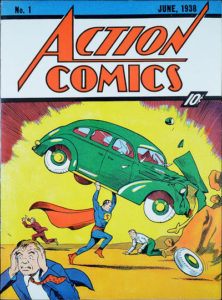Comic books first came to the US market in the 1930’s, though their history dates back to 18th century Japan. Since 1939, comic book collecting as a trend and in turn comic book values, have waxed and waned through the years. Since the 2000’s, after suffering a severe decline in interest, comics have once again become a favorite of collectors. People (and businesses) collect comics for a number of reasons ranging from the joy of collecting a series of stories, to a particular artist’s contribution to an issue, to achieving financial gain. Action Comics No. 1, released in June of 1938 is the most sought after comic in the world. A near-mint condition sold at auction on eBay for $3.2 million back in 2014, not a bad price for the first appearance of Superman that sold for 10 cents in 1938.
The Situation
Enservio Select was recently called in to handle a theft claim which included two Golden Age comics (comics published anytime between the late 1930s to the early 1950s), one with a stated value of approximately $20,000, and the other without a value.
Unfortunately, the policyholder was unable to provide any photographs, pre-loss appraisal or any other documentation which provided condition. The only information that was provided was that one comic was a 1939 Action Comics issue #15 in good, 2.0 condition which featured Superman, and the other, a 1939 Detective Comics issue #31 also in good, 2.0 condition, which featured Batman.
Cracking the Case

When it comes to valuing comics, along with rarity, marketability and restoration potential, condition is crucial to providing an effective appraisal. On claims such as this, we will typically consult industry pricing databases of used comics to assist in providing a replacement value based on a grading system.
To provide some context, a nearly perfect edition, or “Gem Mint” comic, would be graded as a 10—comics from the age of this claim are virtually non-existent; whereas a Poor Grade of below 1.0 could have much of the cover missing, be stained, torn or missing pages, etc.
In this case, the policyholder listed them as 2.0 Good.
“Good” can be very misleading in this context, as numerically, 2.0 is near the bottom of the scale, and includes those comics that may have yellowing, a portion of the cover torn, be stained, have mold or mildew, etc., but are still in readable condition.
In order to provide a defensible value, our appraiser knew it was crucial to obtain a grading consensus. Working with the policyholder, we found that though they rated the comics as 2.0’s based on their grading knowledge, they had never been professionally graded. Our specialist did know the appropriate questions to ask in order to narrow down the grading, and agreed that what the policyholder had could certainly have been in the realm of a 2.0 “Good” comic.
The Results
Combining the grading information with extensive research of the current comic market and comic pricing databases led us to establish retail replacement value for the Superman Action Comic to be $1,280. The Batman Action Comic, which is a more sought after issue than the Superman comic, was determined to be valued at $6,400.
Steve Leone is a review appraiser for Enservio (www.enservio.com), a provider of contents claim management software, payments solutions, inventory and valuation services for property insurers. He has held auctioneer positions at Cole auctions, Abdou auctions, Flanagan Auction Gallery, Carver Auction Gallery and the Stutz Blacker Auction Company. Leone’s knowledge of antiques and collectibles includes estate silver, porcelain, custom and antique knives, edged weapons, firearms, antique clocks, antique furniture and collectibles of all types.
Was this article valuable?
Here are more articles you may enjoy.


 Munich Re: Insured Losses From Wildfires, Storms and Floods Hit Record High
Munich Re: Insured Losses From Wildfires, Storms and Floods Hit Record High  Musk’s X Probed by UK Over Grok’s Thousands of Sexualized Images
Musk’s X Probed by UK Over Grok’s Thousands of Sexualized Images  Palantir Poaching Suit Called ‘Scare’ Tactic by Ex-Employees
Palantir Poaching Suit Called ‘Scare’ Tactic by Ex-Employees  Cyber Breach Affected 750,000 Canadian Investors, Regulator Says
Cyber Breach Affected 750,000 Canadian Investors, Regulator Says 